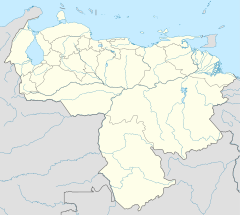San Esteban National Park
| San Esteban National Park | ||
|---|---|---|
|
|
||
| Location: | Carabobo , Venezuela | |
| Surface: | 435 km² | |
| Founding: | 1987 | |
The San Esteban National Park (in Spanish Parque Nacional San Esteban ) is located in the state of Carabobo , in the center of Venezuela . The park is located on the northeast side of Carabobo and borders the Henri Pittier National Park of Aragua. Both are nature reserves.
The park was established in 1987 and is 43,500 hectares in size. It extends over the parishes of Guacara, Naguanagua, Puerto Cabello, and San Diego.
Historical sights
- Solano fortress
- The village of San Esteban
- The house of General Bartolomé Salom
- The old colonial route or 'Route of the Spaniards' that connected Valencia to Puerto Cabello
- The Paso Hondo Bridge on the San Esteban River
- The Indian salt route between Patanemo and Guacara
- The Hacienda Quinta Pimentel
- The thermal baths of Las Trincheras
- The island of Isla Larga, where the remains of a German ship from the Second World War lie
- Vigirima petroglyphs
flora
There is a very large variety of plants in the San Esteban National Park: from xerophilic plants to bushes to those typical of tropical forests.
It is assumed that over 125 families, 703 genera and 1520 plant species live here.
On the coast there are mangroves like the red mangrove and coconut palms like the Coccoloba uvifera . In the south there are cacti and other piercing plants. At 200 to 400 meters above sea level there are dry forests with deciduous trees. At 700 meters above sea level you can find more and more deciduous trees like the yagrumo Cecropia spp. , the Casia sp. , of Inga sp. , the Araguaney ( Tabebuia chrysantha ), the matapalo ( Ficus sp. ) and the Bucare ( Erythrina sp. ). At 900 meters above sea level and higher, the forests become greener and more lush. Then palm trees like the Macanilla ( Bactris setulosa ), the Caña de molinillo ( Chamaedorea pinnatifrons ), the Palma de cacho ( Dictyocaryum fuscum ), the Palmita de sombra ( Geonoma sp. ) And the Palma prapa ( Wettinia praemorsa ) mingle . There are also lianas and large trees such as the cucharón ( Gryanthera caribensis ).
fauna
In the park are inter alia the following birds before: the Flechtenglöckner ( Procnias averano ), the Northern Helmhokko ( Pauxi pauxi ), the crab heron ( Nyctanassa violacea ), the Yellow-crowned Amazon ( Amazona ochrocephala ), the brown-throated parakeet ( Aratinga pertinax ), the green-tailed emerald hummingbird ( Chlorostilbon alice ) and the red-tailed guuan ( Ortalis ruficauda ).
On the coast you can see the brown pelican ( Pelecanus occidentalis ) and the magnificent frigate bird ( Fregata magnificens ).
Of the mammals the following species occur: Jaguar , the Puma , the Ocelot the tapir , the collared peccary and Paka .
There are numerous species of snakes, including a number of Bothrops snakes, such as the tigra mariposa ( Bothrops venezuelensis ), the viejita ( Bothrops medusa ), the Bothrops atrox and the Bothrops colombiensis , as well as corals such as Micrurus sp. and Micrurus mipartitus semipartitus .
Other snakes that are non-venomous and live in the park include:
- Idol snake ( Boa constrictor )
- Cazadora negra ( Clelia clelia )
- Tigra cazadora ( Spilotes pullatus pullatus )
- Sapa ( Umbrivaga mertensi )
- Reinita ( Leimadophis Doubti )
- Cazadora ( Rhadinaea williamsi ).
Some of the animals that live in the San Esteban National Park
There are also specimens of the caiman Crocodylus acutus , but it is critically endangered.
The tortoise Geochelone sp. and the common lewan Iguana iguana .




